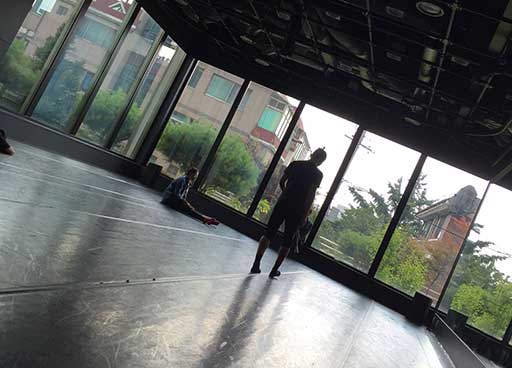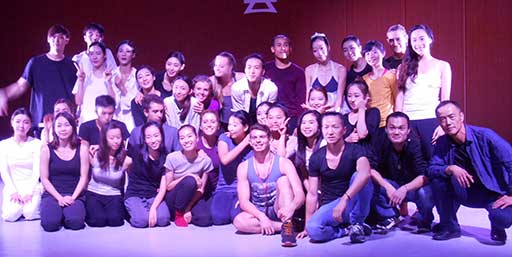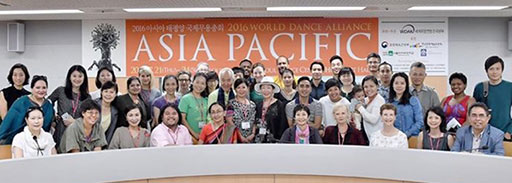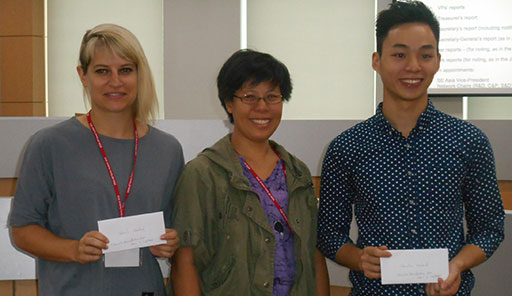Returning to Seoul, as a familiar ‘other’ was an anticipated experience, to say the least. In 2013 I was fortunate enough to be one of two Australian artists to be embraced with dancing arms into the Australian Korea International Cultural Exchange (AKICE) program creating a collaborative cross-form work within the local community of Mullea. It was an enriching experience and certainly set expectations for my return.
Stepping out into Seoul felt familiar, the smell of the hot thick air entangled with the guttural anticipation of artistic and global exchange. Arriving, this time, to submerge myself within the World Dance Alliance Korea Festival and Conference as dancer and researcher-choreographer.
ChoreoLab
I am one of forty dancers from across the globe. As we ride the bus across town from our Life Hotel to the Seoul Dance Centre, an illustrious building with stunning open and sunned studios, we are ‘others’. We are others in culture, in language, in training, in generation and in expectation. Yet, of course, these roots of differentiation would seem to separate us but in fact, draw us closer through our connectedness and curiosity in dance. Over an intense six days of creative development, five newly formed groups sweat, charge, exchange and thrive in the studio creating five new works,
feet and knees skim the floor, skin stretches to reach new bounds of spatiality. Vocalisations of horror, childbirth and happy-hour are matched with alien like splayed hands across eyeballs and poised bird like stillness. Electric toy cars race between bodies and ripples travel from toe to scapula—and we step on stage.

The process is fast, challenging, rich and reaffirming. The otherness that defines us as individuals is embraced and, as WDA host Hong Jo Jun commented, through the development process we became a family. For me it was refreshing to be immersed in another’s creative process experiencing choreographic mechanisms from the inside out. Of course this is not a new model, however, in the context of an international laboratory the lens in which it is experienced is altering. The point of difference is within the rerouting of communication boundaries, shifts in aesthetic, identification of trends in the dance landscape and embodying the unique qualities of each artist. It is an emergent mix of the familiar and the other amalgamated in creative exchange. This is what makes the laboratory an exciting platform—the embracing of artistic difference. I am forever grateful for the whirlwind of time we spent sharing and creating.

 Choreolab choreographers and dancers (with facilitator Jin-Wen Yu kneeling on the far right). Photo: Julie Dyson
Choreolab choreographers and dancers (with facilitator Jin-Wen Yu kneeling on the far right). Photo: Julie DysonThe conference
Over four days diverse communities from Korea, Taiwan, Thailand, England, America and New Zealand, to name a portion, came together to share their work, words and visions of and for dance. Kicking off the first day I was able to share my choreographic research within the Pecha Kucha presentations,
Microphone held tightly as I circle to address my audience. Introductions, context and reference fly. Embodied practices are woven into choreographic ritual. Imagined otherness and I diving head first into creative potential—words and body. I dance. Limbs lash and fingers curl grasping at heart, mind and soul. It is a conglomeration of mediums in medium
and with that, my work at the festival and conference concludes. I am able to then sit back and become a sponge—listen, view, compute and contextualise the voices of many. In reflection the themes that remain strongest for me are ones of diaspora, of tradition versus contemporaneity, of globalising expectation, technique and aesthetic, of recontextualisation and boundaries, of redefining and defying the physical, the drifting heterotopic body, of subaltern imaginative histories, of heterogeneity, of rupture over reinscription, of dance,
dance,
dance,
dance,
dance…

So, in the words of one of the final speakers Andree Grau, ‘believe nothing...all knowledge is situated’ and therefore we must rupture that of others in order to reroute art-form practice and individual knowing. We must embrace our ‘otherness’, which, in fact, is what makes us artists in the first place. I leave World Dance Alliance Korea feeling full, enriched, motivated and looking forward to the prospect of Canada in 2017. A true meeting of body, mind and soul—in Seoul.
Nerida was awarded the inaugural Chin Lin Award for best emerging researcher for her presentation on rerouting the choreographic self through processual experimentation.
 Chin Lin Foundation winners (Joseph Wai-nang Lee—Hong Kong, and Nerida Matthaei—Australia) with Cynthia Lee, who made the presentations. Photo: Julie Dyson
Chin Lin Foundation winners (Joseph Wai-nang Lee—Hong Kong, and Nerida Matthaei—Australia) with Cynthia Lee, who made the presentations. Photo: Julie Dyson
